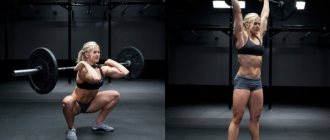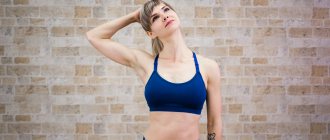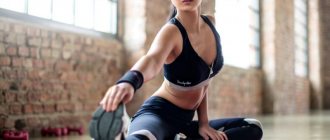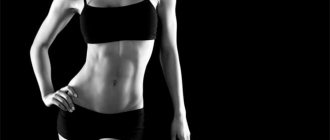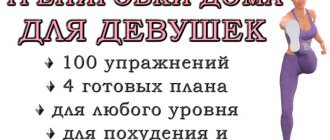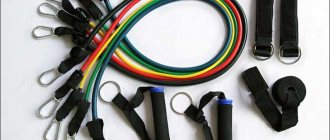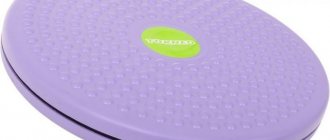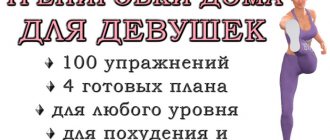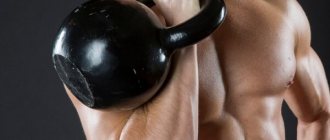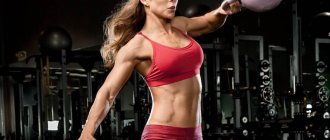Share:
What you need
- Barbell
- Platform
Thrusters with a barbell (throwouts) are one of the most common movements in CrossFit, both among beginners and among professional athletes.
The reasons for its popularity are simple:
- Firstly, thrusters are a relatively simple movement; to perform them you only need to master two basic exercises: front squats and press presses;
- Secondly, along with the deadlift, bench press and squats with a barbell, this exercise is a universal measure of an athlete’s training; thirdly, thrusters contribute to the development of phenomenal strength endurance, as they involve almost all large muscle masses.
Today we will look at the main points that you need to know before you start practicing this movement, namely:
- Why are thrusters with a bar needed?
- Technique for performing the exercise - how to do thrusters correctly.
- What errors occur when performing this exercise.
What muscles do barbell thrusters work?
In principle, thrusters with a barbell use the muscles of the entire body, but more basic ones can be distinguished. In the initial phase of the movement, the load falls on the legs; it is thanks to their flexion and extension that we impart inertial movement to the bar, which in turn helps to squeeze it above the head. Investigators, several muscles can be distinguished:
- Quadriceps.
Due to the placement of the barbell on the chest, the load on them is much greater than in SQUATS WITH A BAR ON THE BACK. Responsible for straightening the legs at the knee joint. - Gluteal muscles.
The middle and small ones stabilize the femur, and the gluteus maximus is responsible for extending the legs at the hip joint, as well as stabilizing the torso. - Gastrocnemius and soleus
. Stabilizes the leg at the ankle and knee joint. - Muscles of the back of the thigh.
In this exercise, they receive less load than the quadriceps and perform mostly a stabilizing function.
The adductor muscles also work, but still these are not PLIIE SQUATS, so counting on their significant development when performing thrusters is not entirely objective.
In the second phase of the “press” exercise, the load shifts to:
- Deltoid muscles.
All 3 beams work at once, without any specialization on one of them. - Triceps.
What kind of bench press can there be without engaging this muscle? The triceps responds to extension of the arm at the elbow joint. - Pectoral muscles.
When performing thrusters, the pecs, of course, do not receive the proper load, but this does not mean that they do not work in this movement. - Trapezoid and diamond-shaped.
These muscles are responsible for the movement and stabilization of the shoulder blades.
Other muscles, such as biceps, forearm muscles, latissimus, back extensors, work more statically and perform a stabilizing function. Separately, I would like to highlight the core muscles.
Although they are also stabilizers, when performing thrusters they bear a colossal load.
KLOKOV'S LADDER FROM GRID
The National Grid League was founded in 2014 by Tony Budding. A team tournament format that allows athletes who specialize in one event to get their chance, meaning Olympic weightlifting world champions will be an extremely welcome addition to the teams. A few years ago, Dmitry Klokov showed a show in the Thruster Ladder task, lifting 175 kg.
Try it
Perform Ladder Cover: 3 minutes 9 weights (pick up your own)
Advantages and disadvantages
Advantages
- The first reason to perform this exercise is to strengthen the muscles of the legs, especially the quadriceps (due to the location of the bar in the front) and gluteals, since thrusters involve a deep squat below parallel.
- Development and strengthening of the deltoid muscles. This reduces the risk of injury to the shoulder girdle and increases the weight in basic bench press exercises.
- Strengthening the abdominal muscles. It is a well-developed press that reduces the risk of back injuries. Nowadays there is such a tendency in the gym to give preference to exercise machines rather than free weights. Because of this, the core muscles do not receive the proper load. Thrusters will correct this imbalance.
- Improved coordination. Most exercises in CrossFit require the athlete to balance the weight well, since these movements consist of several elements. Without coordination, it will not be possible to achieve technically correct execution.
- Developing endurance and strengthening the cardiovascular system. This allows you to get more work done in a shorter period of time.
- Strengthening and improving joint mobility. CrossFit athletes are more flexible than bodybuilders and even more so powerlifters. And without proper joint flexibility, it will be difficult to perform other training elements in the future.
Flaws
- When performing thrusters, the legs do not receive the proper load. What is it about? The leg muscles are stronger than the deltoids, and all that we can squeeze overhead will be small for the quadriceps and gluteal muscles at the time of squatting. If you are in a mass-gaining period, thrusters are unlikely to suit you.
- Now let's talk a little about the grip. To perform front squats, we need to put our elbows forward, which will make it easier to maintain an even body position in the lower phase. But because of this, we will not be able to fully grasp the bar, since the flexibility of the wrist joint will not allow us to do this. Now let's look at how to perform the OVERHEAD BAR PRESS. Athletes grab the bar with their entire palm, but they won’t be able to push their elbows forward, but they will be able to squeeze out much more weight. What am I getting at? Thrusters, although they consist of two exercises, but the grip forces us to choose either squats with the correct placement of the elbows, or the maximum potential on the bench.
That is, in fact, although thrusters are an excellent multi-joint exercise, they are not suitable for the role of mass-gaining. There is a solution to this problem. You can break them into two separate exercises and perform them as a drop set. That is, first we do front squats, then we change the weight and perform overhead presses.
CrossFit new or forgotten old
This is a fashionable system of cyclic training today. Its founder is considered to be the American Greg Glassman. The training program itself is divided into so-called daily workouts, which include a series of different exercises that must be performed with high intensity.
You can't get bored with CrossFit. Every day is filled with a variety of exercises that squeeze all the juice out of the athlete. Often classes are structured using the following exercises and types of loads:
- Running (usually short distances, shuttle).
- Rope climbing.
- Exercises with dumbbells, kettlebells and barbells.
- Gymnastic elements (horizontal bar, rings).
- Carrying heavy things.
- Jumping and exercises with a skipping rope.
The average training duration is only 20-30 minutes, but due to the high intensity, the athlete is completely exhausted during this time. And from the first time, not every trained athlete will be able to complete the daily complex in one go and complete it within the allotted time.
Most often, this system is positioned as an extreme training system. After reading the above description, many athletes, especially those who were involved in wrestling back in the Soviet and post-Soviet years, may - what’s new here? After all, the practice of using circuit training with maximum effort has existed for a long time.
This method of training is practiced by wrestlers and boxers to train endurance and explosive strength. This technique is called general physical training (GPP). Here is an example of one of the circular complexes from Soviet times:
- Push ups;
- Press;
- Squatting or jumping;
- Shuttle or long distance running.
Sometimes the complex is combined with exercises with a sledgehammer or hammer. As we can see, the above method of general physical fitness training fits the description of the CrossFit system. At the same time, the Western version is more saturated with a variety of exercises, which make the training process more varied; work is carried out with different types of loads.
Execution technique
Thrusters with a barbell are a complex exercise, so it is better to start mastering it with an empty bar or bodybar. Next, you need to decide how you will lift the barbell. In CrossFit, it is customary to lift it from the floor by throwing it; bodybuilders prefer to use racks for this.
Initial position:
- When lifting the barbell from the floor, we need to assume a position similar to a CLASSIC DEADLIFT. We approach the bar so that the front of the shin almost touches it. We place our feet shoulder-width apart. We squat by moving the pelvis back. We grab the bar with our palms. As you exhale, we begin to straighten your knees, thereby lifting the barbell off the floor. Having reached the bar almost to your waist, perform a squat and jerk the barbell over your shoulders (the movement resembles a BAR PULL TO THE CHIN, with the shoulders turned outward.
- If you plan to take weight from the racks, then everything is much simpler. We set them to the desired height (just below the deltas). We approach the bar, place our feet shoulder-width apart. We crawl under the barbell by slightly squatting. Place the bar on your deltoids and collarbones. We put our elbows forward, fixing the barbell and grab it with an open grip from below. Next, straighten your legs and remove it from the racks. Let's take a small step back.
Performance:
- Inhale and tense your abdominal muscles, moving your spine to a neutral position.
- Next, we begin to bend our knees. We lower ourselves until the pelvis becomes parallel to the floor. If you do CrossFit, then you need to perform deep squats, that is, your hips will be below your knees, while your heels do not leave the floor.
- Next, as you exhale, we shift all the tension to the heels. By contracting the quadriceps and gluteal muscles, we push ourselves up, straightening our legs at the knee and hip joints. At the same time, we straighten our elbows and press the barbell up until our arms are completely straight.
- The squat exit phase creates an initial impulse that is transmitted to the barbell, giving it acceleration.
- Next we repeat the same thing in the opposite direction.
- We lower the bar down, as soon as it touches the shoulders we go into a squat.
- We repeat these movements for a specified number of times.
Exercises
Each complex strength exercise requires attentiveness, concentration and correct execution. To avoid injury and other undesirable consequences, the following rules for the execution of the thruster must be observed.
Barbell Chest Raise
The beam should be in front of the athlete on the shoulders, and the bar should be on top of the back. During squats, keep your back straight so that the bar is over the center of your foot. This way it will hold up when squatting.
Thrusters require athletes to have good flexibility in the wrists, shoulders and hips. Therefore, the CrossFit technique with a barbell on the shoulders is much more difficult than squats with a barbell on the chest, since the back must always be straight, without the slightest bending.
Important! The thruster is designed to train endurance; with such exercises, the quadriceps and deltoid muscles are well pumped, and the heart rate also increases.
Front Squat
The front squat is aimed at training the legs. When performing a front squat, your heels should not come off the floor, so you keep your weight on them. Pull your elbows and then stand up. It works the hamstrings, quadriceps, glutes, and the front and back of the body.
Did you know? CrossFit competitions have been held since 2007. An interesting thing is that the disciplines in which athletes will compete are announced only a few hours before the start of the games.
Barbell overhead
From a front squat, you should smoothly move into a standing position with the apparatus overhead. In CrossFit, this transition occurs simultaneously. When getting up, you must throw the barbell up until your arms are completely straightened, then fix the bar in this position for a few seconds.
Recommendations for implementation
- In the starting position, your elbows should be raised up, this will allow you to hold the barbell on your shoulders, and during the squat will prevent your torso from leaning forward.
- Don't round your back or roll your shoulders. This may cause the barbell to fall.
- During the squat, the body should remain vertical. Leaning forward is not allowed! This will cause you to lose your balance and cause the bar to slip.
- Most beginner athletes cannot go into a deep squat due to low flexibility of the lower leg muscles, especially the back part. Therefore, at the initial stage, squat until your heels remain firmly pressed to the floor. Their separation is not allowed, as this will create a large load on the knee joints.
- When squatting, do not bring your knees past your toes. To do this, you need to move your pelvis back a little.
- Don't arch your back when doing overhead presses. If you can't press the barbell using your pressing muscles alone, it means you've taken too much weight or created poor acceleration when coming out of the squat.
- At the top phase of the movement, you need to fully straighten your elbows and press the barbell straight above your head. It is important that your entire body from your heels to your toes is in the same plane.
- When performing a bench press, you do not need to do an additional squat as in the shvungs. There is one continuous movement from the moment of straightening the legs to straightening the arms.
- All elements of the exercise must be under your control. There is no need to drop the barbell on top of your chest or suddenly go into a sitting position under its weight.
Basic mistakes
The main mistake is holding the barbell using the strength of your arms, in which it does not fall onto your shoulders. In this case, there will be constant tension in your arms, extra work is done and a full release will not occur, since your arms will absorb your explosive force from your legs. When performing a front squat, the barbell should lie on the shoulders only held by the hands; during this phase, the arms should be relaxed. The most common cause of this common mistake is lack of mobility. Let’s say that for those who have already been involved in powerlifting or bodybuilding, but neglected stretching, the arm simply does not fold, the shoulder and wrist are “wooden”.
The next common mistake is performing a squat on the press. Although some competition organizers allow this, in a standard thruster the barbell is thrown in one continuous movement without squatting.
The next mistake is lifting the heel and moving to the toe in a full squat position. This is often accompanied by a hunched back, which is unacceptable.
Tips for maximum efficiency
- Before performing thrusters, you should do a set of WARM-UP exercises. We pay special attention to the knee, hip and shoulder joints.
- Beginning athletes should first work on exercise technique and joint flexibility. Therefore, at the end of the workout we perform a COOL-DOWN and stretch the muscles of the hips, lower legs and shoulders.
- If you feel pain in the wrist joints, then you can use special elastic bandages.
- There is also one more simplified version of thrusters that is performed in the landmine simulator. When working in it, you don’t need to worry about not being able to hold the projectile, since one edge of the bar will be fixed. Plus, the movement occurs along the trajectory specified by the simulator, which will allow you to focus all your attention on the work of the muscles.
- Before you start performing thrusters, it’s worth mastering simpler elements. Goblet Squats and DUMBBELL OVERHEAD PRESSES are great alternatives for beginners.
As you can see, the exercise thrusters can be most effective with the right approach. You should not try to immediately set a strength record; a much more effective solution would be to master the technique of the exercise, and then increase the weight of the barbell. If you want to increase your muscle mass, then break the thrusters into two separate movements using the drop set principle and perform them alternately without resting in between.
Good luck to everyone in your training!
The use of thrusters in other sports
Thrusters are performed not only with a barbell. Athletes use weights, sandbags, medicine balls, dumbbells, and barbell plates as weights. Thrusters with weights and dumbbells are more difficult to perform, since the muscles that stabilize the arms are involved in the work.
Athletes of other sports include thrusters in their training to develop strength endurance and quickly lose weight.
In what sports are thrusters used in training:
In training complexes, thrusters go well with burpees, bringing your feet to the bar, and jumping on a stand.h
What you need for training outside the gym
If you plan to train CrossFit at home, then you will need a free area - a couple of square meters or more, as well as:
- a gymnastic mat, mat or any dense, but not too soft bedding;
- weights: dumbbells, weights or simple water bottles, tubs of water weighing up to 5 kg;
- horizontal bar or crossbar;
- jump rope
For exercise on the sports ground or in the park, in addition to the stated weights and jump ropes, the following will also be useful:
- horizontal bar, wall bars, parallel bars;
- bench, bench and any other apparatus that you can jump on, height approximately 50-60 cm;
- street exercise equipment (running, cycling, etc.);
- running track – minimum 100 m.
A street CrossFit workout can begin and end with a run, a bike ride or skiing if winter suddenly comes. A good street workout can consist of jogging to the sports complex located in the park, exercising there and running on the way back, of course.
Of course, over time, it is advisable to purchase some simple professional equipment: a sandbag, a barbell or a weight. That is, practically equipment available when training in the gym.
Why are they needed?
Kettlebell thrusters are considered a key exercise in CrossFit. They are also recommended to be included in the program when preparing for any strength sports, to be used by those who have weakened muscle corsets, ligaments, and for the prevention of various diseases affecting the musculoskeletal system.
Emissions are recommended to be added to the training process by professional athletes and beginners, and all because they:
Week schedule
Thrusters with weights, unlike exercises with a barbell, can be performed in any convenient place. So, for example, if you can’t visit the gym, then you can go for a run in the morning - this is an ideal cardio workout, and then work out all the muscles by doing several approaches with weights.
But it is better to first develop a training program in order to ideally pump up all muscle groups and make the body more sculpted and beautiful. For beginners, it’s better to turn to a professional who can choose the optimal load, for example, buy a gym membership and take a few lessons from an experienced trainer.
When creating a program, you need to consider several important factors:
- amount of time spent on classes;
- the tasks that the athlete sets for himself;
- experience.
Beginners should work with light weights, gradually increasing them as their muscles strengthen. So, you should definitely start training in the gym or at home with just a warm-up; you need to let the muscles warm up so that sudden loads do not cause injury.
After warming up, you can move on to performing thrusters:
- perform a thruster, where 1 weight is held by 2 hands 10 times, then you need to rest for a minute and perform 1 more approach;
- Perform the exercise 10 times with 1 hand, change hands and 10 more times;
- thruster with 2 kettlebells – 10 times, break and 1 more approach.
After training, be sure to do stretching, which will help the muscles recover after training.
It is better to train 3-4 times a week, taking days off to allow the muscles to recover. With each new day of training, you need to add load, but not reduce it - the muscles should work actively, and the load should increase. You can add repetitions or approaches.
Device fields
Each of the four thrusters share a set of common device fields (below), but the plasma thruster has additional device fields owing to its unique characteristics.
| YOLOL field | description | range |
| ThrusterState | Requested output of the thruster | 0 — 10 000 |
| ThrusterCurrentThrust | Current output of the thruster | 0 — 10 000 |
In addition to these, the plasma thruster has two extra fields.
| YOLOL field | description | range |
| isactive | 1 = charge ; 0 = discharge | |
| chargelevel | the current charge level of the plasma thruster, must be 1 to produce thrust | 0 — 1 |
To learn more about how to use fields, consult these wiki pages:
- Universal Tool
- Data networks
- YOLOL
Alternatives – standing dumbbell press
There are plenty of alternatives to the classic bench press. In women's training, they often use seated presses on a fitball to turn on the stabilizers, but it is better to choose a simpler option to load them - just press a barbell or dumbbells while standing.
The second “alternative press” option is the kneeling position. It is intended strictly for those people who do not know how to use their legs and are constantly trying to shunt, that is, push the working weight by sharply bending the knees. This does not give the feeling of isolated work, and develops completely different qualities - explosive strength and footwork.
The standing dumbbell press option allows you to:
- Take more weights, as the body position is more stable and more natural for lifting weights;
- Develop stabilizers from the foot muscles to the core muscles;
- Promote the development of strength in barbell presses, cleans and jerks;
- Work in a plane natural to the human anatomy and do not damage the joints
A technique to stabilize the center of the body is used. The athlete strains his quadriceps, buttocks, as if he were pressing his feet into the floor, pulls the abdominal wall towards the spine, draws in the stomach and brings the shoulder blades together, lowering them towards the spine. At the same time, the trapezius and shoulders remain relaxed.
Technique
- The dumbbells are brought to the shoulders by standing up, that is, the knees are slightly bent and the weight is brought to the shoulders in one powerful movement;
- The athlete stabilizes the core as above;
- Due to extension in the shoulder and elbow joint, it moves the dumbbells upward;
- Lowers them smoothly to the shoulders;
- The peculiarity is that dumbbells move along a “flat” trajectory than a barbell;
- There is no need to bring them behind the head, as is emphasized in the movement with a barbell.
It's the STANDING DUMBELL PRESS, baby!
Watch this video on YouTube
Recommendations
- For bodybuilding and fitness purposes, it is not recommended to completely “stick” your elbows at the top point;
- You need to avoid a flat trajectory, and try to move the dumbbells slightly to the top of your head, and not to your forehead;
- Complete relaxation of the arms, as well as “releasing tension” from the center of the body by relaxing the abdomen, is not allowed;
- The weight for strength training is lifted no more than 5-6 repetitions, there should be no more than 5 approaches.
Errors:
- Shvung weight, that is, acceleration and pushing with the legs;
- Rocking the body back and forth;
- “Strong’s” technique” in which the athlete seems to “roll” the dumbbells onto his shoulders in each repetition, and “push” the dumbbells with his stomach and chest at the start
Dumbbells can be replaced with weights. In this case, you need to start from shoulder level, but your palms should be directed towards each other. In the process of moving upward, the projectiles turn, as in the Arnold press. Some athletes initially press with their palms facing forward, but this position is quite traumatic for the wrists.
